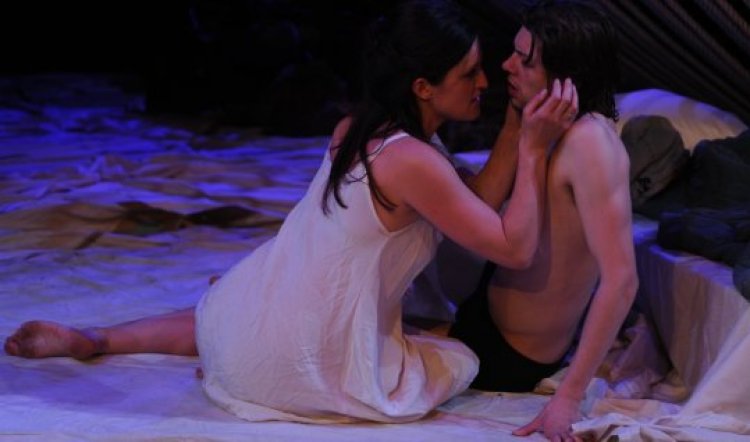
JUDITH
JUDITH by Howard Barker, The Impending Room with Tamarama Rock Surfers at Bondi Pavilion Theatre, 18 October-6 November 2011. Photos Heidrun Lohr: Benedict Samuel and Luisa Hastings Edge. Right: Anna Houston.
Caravaggio’s masterpiece Judith Beheading Holofernes is probably the most famous of the many oil-on-canvas depictions of the gruesome apocrypha and is apparently the inspiration for Howard Barker’s 1992 short play. However, from this independent production it would appear to have much more in common with Judith Slaying Holofernes, the much more muscular and in-your-face version by proto-feminist Artemisia Gentileschi.
Caravaggio’s elderly Servant looks on, grim yet impassive, as the youthful widow Judith neatly slices Holofernes’ neck. Her demeanour is as genteel and arm’s length as if she were slicing a Victoria sponge for tea; it’s only the enemy general’s horrified face that tells of murder. Gentileschi’s depictions are something else again: there is passion, vivid energy and clear motivation in both pictures (one in the Uffizi in Florence, the other in the Museo de Capolodimonte, in Naples).
Gentileschi’s two women are of similar age and are actively complicit in the killing; the plan might be to slay the Assyrian general and save the Israelites but there are signs of other incitements. The canvases are most likely to have been painted around the time of the infamous rape trial when Gentileschi – the victim – was tortured and publicly humiliated to prove her honesty in her case against Agostino Tassi, her teacher and assailant.
Are the pictures Gentileschi’s revenge and wish fulfillment? Do they also hint at an underlying ambivalence – something approaching an Ai No Corrida moment at the limits of obsessive sexual pleasure? For the artist, deflowered and therefore dishonoured by Tassi, the belief that they would marry carried over into a consensual sexual relationship. Betrayal and discovery by her father forced the rape charge and trial and although found guilty, Tassi suffered little (banished for seven years, he was back in Rome within months). The pictures surely depict all of that.
In Barker’s play Judith comes to Holofernes’ tent on a mission to kill but although he displays all the charm and sweetness of a rabid sewer rat, his power and potency are obvious. The verbal sparring and fireworks are unexpectedly funny as well as disconcerting. The seducer and the seduced change places and the tools of seduction are words and ideas, as much as the promise of the physical. At the same time, moments of high farce also have a disconcerting edge. After Judith has post-coitally slain her lover – the beheading is prolonged (although hidden) and sexual in its rhythmic intensity – she is overcome by the memory of the night just past and attempts to mount the still warm corpse. Her servant is aghast but the act is somehow logical – returning for a moment to the idea of sexual obsession and death – and also ridiculous. And it doesn’t work (the attempted sex act, that is).

The prolific and always provocative Barker’s work is rarely staged in Australia, which is a pity. His language – at once poetic and direct – and social and political themes are uncommonly rich and stimulating on many levels. We seem to have a continuing love affair with David Hare while his peers – Barker, Howard Brenton, David Edgar and Caryl Churchill – are pretty much ignored. That first-time director Cathy Hunt wanted so much to do the play is exciting: one of the answers to “where am I? Who am I? And how did I get here?” How can you figure out where “here” is if you don’t know where you’ve been and how you got to wherever it is at the moment?
After mounting what she describes as “a rough reading for an audience of our friends” Hunt and producer Bec Allen were sufficiently cheered by the audience’s obvious interest in the above questions to work towards this production. The cast is led by the standout performance of Anna Houston as the Servant: she’s funny, focused and clear about why she’s there. Luisa Hastings Edge (Judith) and Benedict Samuel (Holofernes) probably need time to settle and dig into the interior lives of their roles, although their fiery psychological and physical debate is promising.
The Bondi Pavilion stage continues to prove challenging to designers and directors alike: sight lines and movement are problematic at times. Designer Michael Hankin has taken his cue from Robert Innes Hopkins’ 1996 thick white rope-tent set for Barker’s own Edinburgh production and, lit by Chris Page, it’s an interesting, effective abode for Holofernes and his visitors. Composer/sound designer Ekrem Mulayim has devised a subtle colour wash for the production: the night winds of the desert set the scene, ambient sounds and a punctuating gong mark out the passage of time and emotional temperature. He’s good. Judith is a short, sharp and fascinating examination of sex and power, humour and horror, imagination and realization. The Impending Room is a new indie house and should be encouraged.



